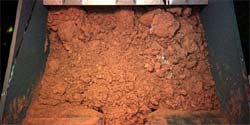Water was quite common in early Martian history, studies reveal
19 Jul 2008
 |
| This image from NASA's Phoenix Mars Lander's Robotic Arm Camera (RAC) shows material from the Martian surface captured by the Robotic Arm (RA) scoop during its first test dig and dump on the seventh Martian day of the mission, or Sol 7 (June 1, 2008). The test sample shown was taken from the digging area informally known as "Knave of Hearts." Scientists speculate that the white patches on the right side of the image could possibly be ice or salts that precipitated into the soil. Scientists also speculate that this white material is probably the same material seen in previous images from under the lander in which an upper surface of an ice table was observed. The color for this image was acquired by illuminating the RA scoop with a set of red, green, and blue light-emitting diodes (LEDs). The Phoenix Mission is led by the University of Arizona, Tucson, on behalf of NASA. Project management of the mission is by NASA's Jet Propulsion Laboratory, Pasadena, Calif. Spacecraft development is by Lockheed Martin Space Systems, Denver. |
A study published in the 17 July issue of Nature shows that large ancient highlands of Mars contain clay minerals, which needed water to form. Volcanic lava buried the highlands, which cover about half of Mars' surface, but craters later exposed them in thousands of locations, NASA said.
The clay minerals, known as phyllosilicates, preserve a record of the interaction of water with rocks dating back to the Noachian period of Martian history, which lasted from about 4.6 billion years ago to 3.8 billion years ago. This was a time in which the Earth, the Moon and Mars were being pummeled by comets and asteroids.
Scientists based their findings on information from the Compact Reconnaissance Imaging Spectrometer for Mars (CRISM) on the Reconnaissance Orbiter spacecraft. CRISM works by "reading" over 500 colours in reflected sunlight to detect particular minerals on the Martian surface - including those that formed in the presence of water.
"The big surprise from these new results is how pervasive and long-lasting Mars' water was, and how diverse the wet environments were," said Scott Murchie, CRISM's principal investigator at Johns Hopkins University Applied Physics Laboratory in Maryland.
Importantly, CRISM detected hydrated silicates - so called because they contain water in their crystalline structure - within sediments that had been clearly deposited by water. The clay minerals were found in fans and deltas within the Holden, Eberswalde and Jezero craters on Mars.
John Mustard, a member of the CRISM team from Brown University, and lead author of the Nature study, said many rocks were slightly altered by water, "but in a few locations they have been so altered that a great deal of water must have flushed though the rocks and soil.
"This is really exciting because we're finding dozens of sites where future missions can land to understand if Mars was ever habitable and if so, to look for signs of past life," he said.
The team also found phyllosilicate deposits in thousands of places in and around craters, including the pointed peaks located at the centres of some impact depressions. This example suggests that water was present 4-5km below the ancient Martian surface, the researchers said. Crater-causing collisions are thought to have excavated underground minerals that were then exposed on the crater peaks.
"Water must have been creating minerals at depth to get the signatures we see," Professor Mustard explained.
The clay minerals must have been formed at relatively low temperatures.
"What does this mean for habitability? It's very strong," he added.
"It wasn't this hot, boiling cauldron. It was a benign, water-rich environment for a long period of time."
An earlier study, published in the June 2 issue of Nature Geosciences, concluded wet conditions existed on Mars thousands to millions of years after the clays formed. Scientists believe that rivers flowed through the highlands and through a delta into a crater lake a little larger Lake Tahoe in California.
"The distribution of clays inside the ancient lakebed shows that standing water must have persisted for thousands of years," Bethany Ehlmann, CRISM's team member and lead author of the study of an ancient lake on Mars, said. "Clays are wonderful at trapping and preserving organic matter, so if life ever existed in this region, there's a chance of its chemistry being preserved in the delta."
Murchie said his team will use the findings to create a list of sites to explore and search for organic chemistry and "perhaps determine whether life ever existed on Mars."






























